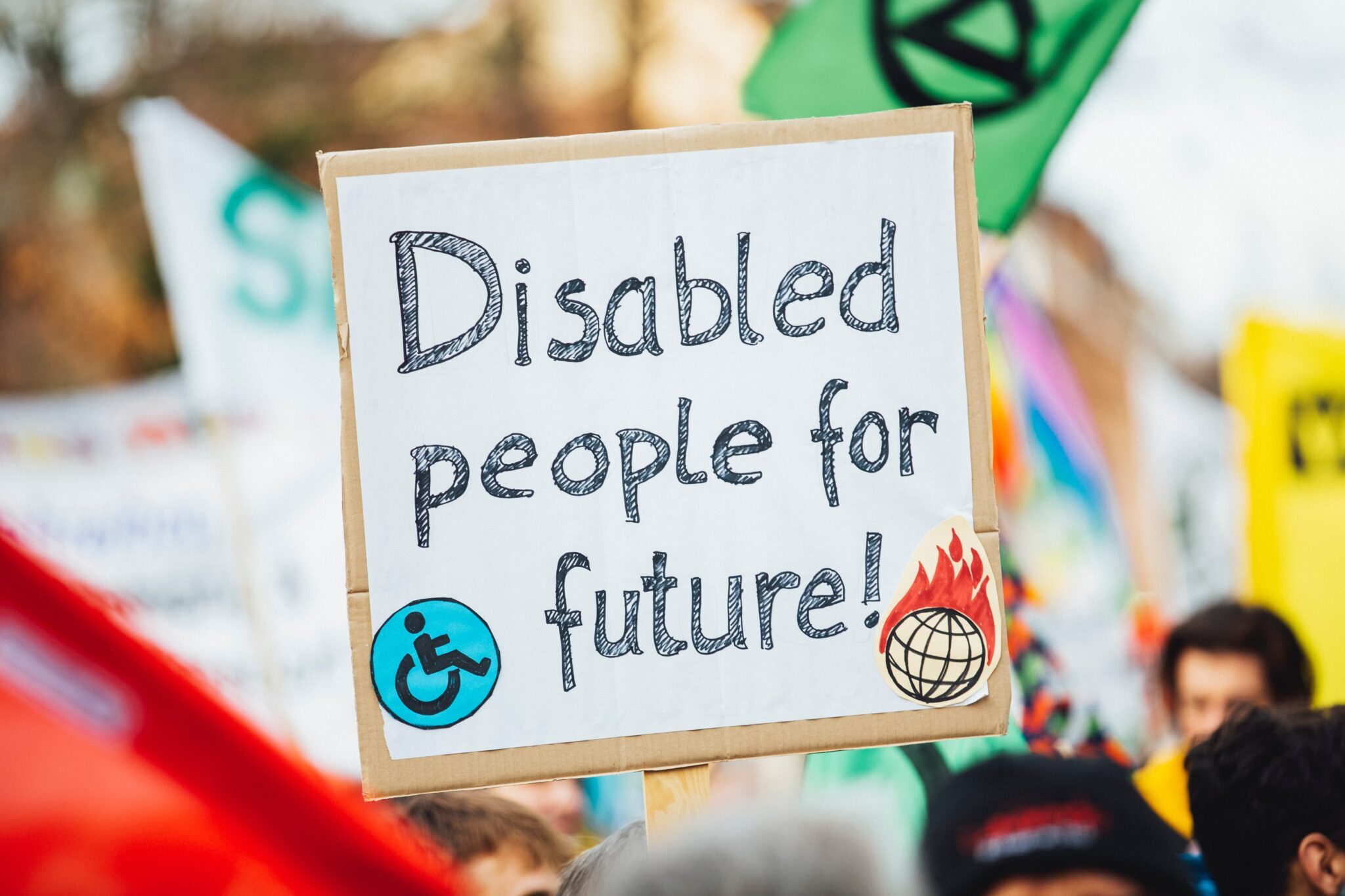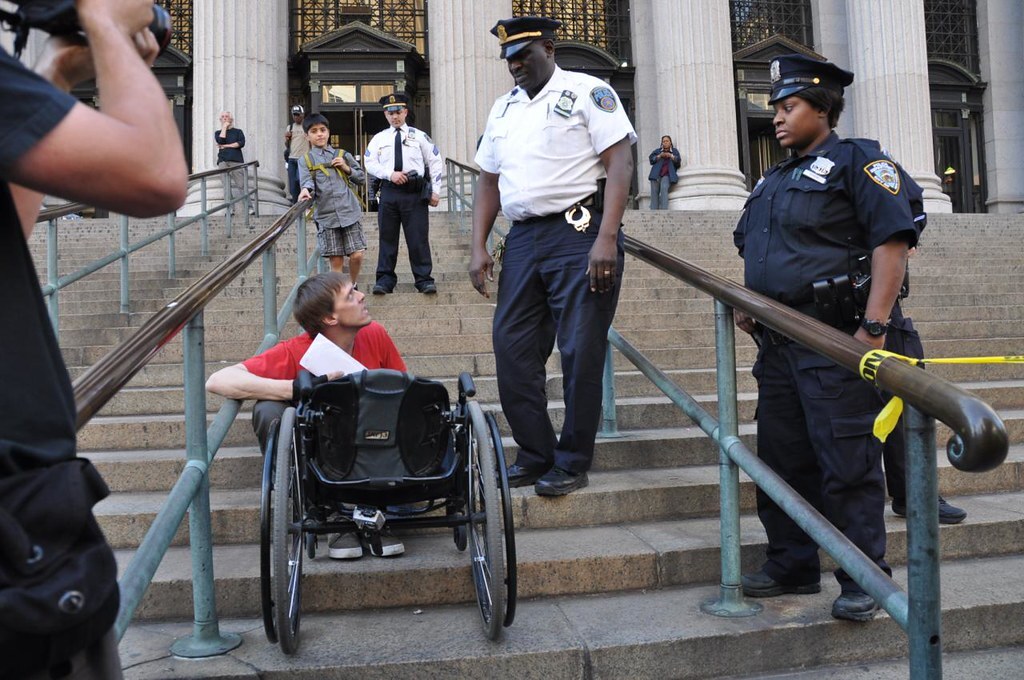Stories
Why disabled imagination offers us all a path towards liberation
It requires us to question everything we assume about the world, and the bodies that inhabit it.
Micha Frazer-Carroll | 27 Jan 2021

A #MillionsMissing protest. Image credit: Omar Wasow.
When it comes to crafting a better world, imagination is the most important tool we have.
After all – in order to create a future that liberates all those who are marginalised – first, we have to dream it up. Feminists have nurtured a long-standing tradition of this kind of dreaming, through activism, writing and art. Writer and organiser Lola Olufemi recently described in her book Feminism, Interrupted: “Feminism is a political project about what could be… It’s a way of wishing, hoping, aiming at everything that has been deemed impossible.”
Disabled people, who naturally share a political project with feminists, have always had to imagine beyond the horizon, in order to simply keep surviving. This is the nature of navigating a fundamentally ableist world. Our society, which prizes individualism, ‘self-sufficiency’, speed, competition, production and profit, is set up for disabled people to fail.
Disabled people are excluded from many of the central structures of society as we know it. In the UK, 42.6% of disabled people are currently excluded from the labour market altogether (not in employment, and not looking for work). Disabled people have been among the hardest hit by austerity – enduring nine times the burden of the average person affected by cuts. Disabled students are more likely to be alienated from our exam-obsessed school system, and drop out of our universities. And to add to all of this, the carceral state routinely punishes us – estimates of disability in our prison population are as high as 36%. So many aspects of this world were not made with us in mind. Consequently, the alternative worlds that disabled thinkers and activists dream up are often deeply radical.
The process of imagining is aided by the use of the social model – a framework that tells us that disability isn’t about a person being inherently faulty, but rather it is society that disables people. Take the example of a wheelchair user having to confront a building with stairs at the entrance. The medical model (which is currently the dominant mainstream model of thought) would tell you that the person isn’t able to access the building because there is a problem with their body: it doesn’t allow them to climb stairs. But the social model, used by many disabled thinkers and organisers, would suggest that there is a problem with the building: it has stairs. This mode of thinking is liberating, and pushes against individual blame or pity. And, once we pinpoint the ‘problem’ of disability as being an external, changeable one, rather than a fixed, internal truth, our minds are opened up to infinite imaginative possibilities. It requires us to question everything we assume about the world, and the bodies that inhabit it.

What if we lived in a world with no stairs? What if there was no wage labour? What if, instead of our isolated units, we lived in interlocking, boundless systems of support and care? What if knowledge wasn’t marketised and rigidly controlled within universities, but available to everyone, wherever they were? What if disabled people weren’t locked away in prisons, but instead given the support that they needed? What if prisons didn’t exist?
Critics will always tell us that these ideas are unrealistic or absurd, but in the last year alone we have seen how the world can change radically overnight. When the Covid-19 outbreak was declared a pandemic, and lockdowns descended across the world, we suddenly saw the application of ideas that had been imagined by disabled people decades ago: notably widespread unemployment benefits, and the normalisation of home working and distance learning. Even before the world suddenly ‘stopped working’, disabled people knew these things were possible, because the world didn’t work for us anyway.
Nonetheless, in each and every historical battle for disabled rights, activists have always been told their demands are too ambitious, too expensive, or even unfair to non-disabled people. Take the Rehabilitation Act, a landmark piece of U.S. civil rights legislation, which was vetoed twice in the 1970s and stalled for years after President Nixon agreed to sign it. In 1972, the President describedthe legislation, which would ban disability discrimination within federally-funded organisations, as “a Congressional spending spree [which] would be a massive assault upon the pocketbooks of millions of men and women in this country”. Other ‘outrageous’ demands can deal in physical structures (e.g. “turn this staircase into a ramp”) or conceptual ones (“give us extra time”) – but either way, they push the limits of what is deemed possible.
This type of radical imagination applies to our very methods of resistance, too. When the public conception of protest is refined to the streets, what do you do when your brain and/or body prevents you from getting there? Writer and artist Johanna Hedva writes in their oft-referenced essay, Sick Woman Theory: “How do you throw a brick through the window of a bank if you can’t get out of bed?”
But as a result of these barriers, disabled communities have often crafted the most novel, creative and evocative ways to show dissent. Today, the #MillionsMissing movement periodically lays empty shoes in public spaces to represent the 25% of ME patients who are unable to leave the house. In 1995, protestors threw themselves out of their wheelchairs and onto the floors of train carriages, in protest of inaccessible public transport. In 1990, US protestors with similar mobility impairments had been crawling up the Capitol steps to publicly demand the passage of the ADA. And the same year, Sue Elsegood, a protestor with the Campaign for Accessible Transport (CAT), helped block traffic on Oxford Street in London alongside other wheelchair users. Her testimony shows how radical imagination galvanised her to join the barricades:
I realised then that buses should be for everyone, including us. Up to that point, I just thought it was my fault I couldn’t walk and couldn’t get on. It’s actually possible to invent a ramp or a lift for the bus, whereas for me to be medically-cured was not within the realms of possibility.

For some, the very idea that disabled people could advocate for themselves is seen as radical – since we are constantly portrayed by the government and media as either the recipients of charity, or problems to be fixed. When the London Mental Patients’ Union was founded in 1973, founder member Andrew Roberts described the utter confusion of a BBC journalist interviewing its members: “How could patients possibly form a union – if they were sick, how could they take part in something like that?”
This kind of head-scratching shows us exactly why disability theory and activism is inherently creative: the implications that come with disabled liberation are deeply threatening to the status quo.
Now is the time for us to dream, and to dream boldly. In their book Care Work, Leah Lakshmi Piepzna-Samarasinha writes:
I am dreaming the biggest dream of my life – dreaming not just a revolutionary movement in which we are not abandoned but of a movement in which we lead the way… I am dreaming like my life depends on it. Because it does.
Disabled imagination offers us all a path towards liberation. After all, the questions I set out above, around architecture, work, care, education and prisons affect each and every one of us. As well as these large-scale questions about liberated futures, we should be asking smaller, imaginative questions every day in our communities too. Who can access the space you have chosen for a meeting? Is there an alternative? Is that person ‘inconveniencing’ you, or do they need support? Is spoken communication the only option here, or might there be others? Does anyone need a rest break?
And we must all ask the most significant question:
Does it have to be that way?